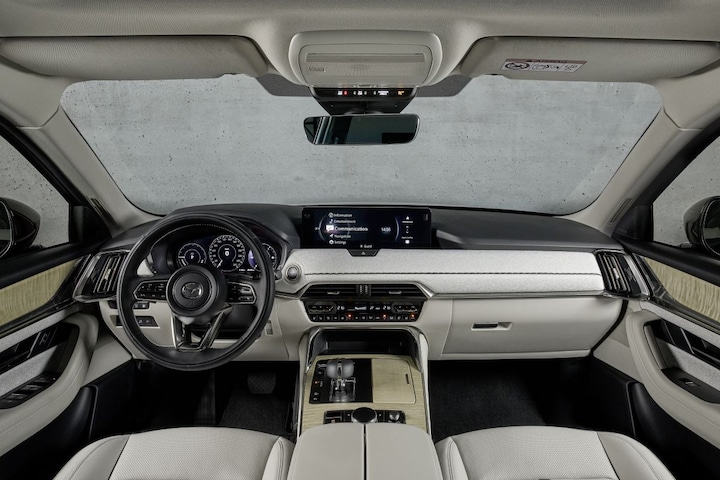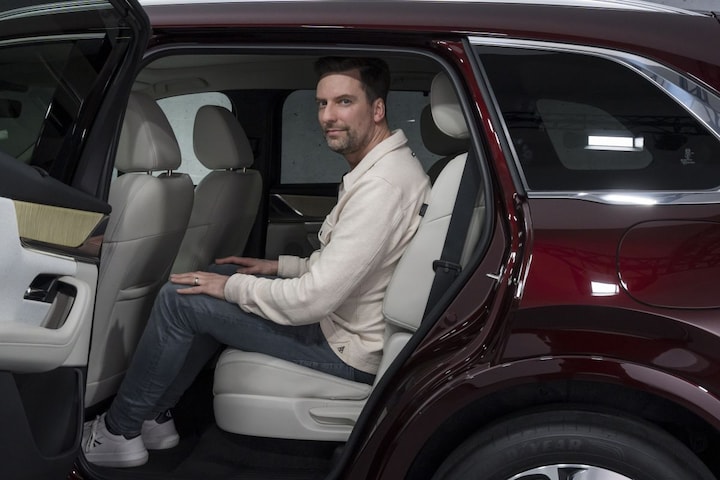This is the Mazda CX-80. A large luxury seven-seater based on the Mazda CX-60.

The number of models with seven seats has fallen significantly in recent years, especially if you cannot afford a lot of money for a car. Mazda thinks it can serve some of those searching customers with the CX-80.
Things may have been different on other continents for a long time, but the biggest Mazda here was the very successful CX-5 for a long time. However, the Japanese wanted more and with the arrival of the CX-60 the battle for the premium car buyer had started. Mazda did not immediately pretend to be a full-fledged premium brand, but it did position itself high enough in the market to be an alternative to the BMWs and Audis of this world. It was a large SUV with quite a presence. The design was almost unanimously appreciated. The interior was a huge step forward compared to the CX-5. The car was also considerably larger, with an engine that had to be behind the front axle and – basically – rear-wheel drive. Inside, it was mainly the width of the car that stood out next to the CX-5. All signals were green for a new step.
Unfortunately, practice was more difficult. The PHEV version, which is important for the Netherlands, was not very refined. The car did not seem fully developed in terms of both drive and chassis. What we cannot always check during a test, but the buyers can, is that the reliability of the car did not appear to be on par. So there is work to be done for Mazda, which received many dissatisfied buyers back at the dealer.

The Mazda CX-80 is 25 cm longer than the CX-60.
Mazda CX-80 is a lot longer than the CX-60
With the next step, Mazda, which is quite guilty about the CX-60, claims to have mastered the problems. This is the CX-80. It is not higher in the market, but is the seven-seater version of the CX-80, just like the Peugeot 5008 is of the 3008. The SUV is no less than 250 mm longer than the CX-60, which is not a small car. The CX-80 is 4,995 mm long, 1,890 mm wide, 1,710 mm high and has a wheelbase of 3,120 mm. As a result, people in the third row of seats still have a reasonable life, although that remains a relative concept in anything that is not a van. Interesting: for the second row of seats you can choose between a sofa or two captain’s chairs. The space between those seats can be left open to move into the third row, or you can opt for a center console. That is a unique offer for a passenger car with three rows of seats. In any case, the rear doors can be opened further to make access to the third row easier. If you opt for a bench, it can be moved by 12 centimeters, so you can choose between legroom or trunk space. With the seats in the third row, the luggage space is 258 liters. This increases to 687 liters with the third row folded and 1,221 liters with the second row also folded. With the seven seats, Mazda believes it can offer a good alternative to more expensive premium models with seven seats such as the Audi Q7, because the number of other, relatively cheaper models that can seat seven people has fallen significantly. The cars that are still available are also a lot tighter than the CX-80.

A particularly beautiful cockpit that is almost 1:1 identical to the CX-60.
Up front it looks extremely similar to the CX-60. There are minor detail differences, especially because some material options have been added. Actually, behind the wheel you can’t tell which car it is. This does mean that you are in a super deluxe environment that can call itself premium without any pretensions. With beautiful materials and a refined finish, Mazda surpasses itself with this car, just like with the interior of the CX-60. AutoWeek already showed you the Mazda CX-80 from all angles in February. So we can imagine that the surprise is not that big, because the CX-80 also looks very similar to the CX-60.
Mazda CX-80 is always a PHEV, at least in the Netherlands
In principle, there will only be one powertrain coming to the Netherlands: the PHEV with roughly the same specifications as the CX-60. A naturally aspirated 2.5 four-cylinder engine with 191 hp is linked to an eight-speed automatic transmission. In between is a 175 hp electric motor. The power is then distributed across the four wheels and with 327 hp and 500 Nm, that is a fairly strong drivetrain. Fortunately, because the car weighs more than 2,100 kilos as a PHEV. You should be able to travel about 60 km on just electricity. The 0-100 time is 6.8 seconds and the car has a limited top speed of 195 km/h. Quite unique for a PHEV is that the car has a towing capacity of 2,500 kilos, which gives it an extra unique selling point.

Plenty of space in the back and the doors open up to 90 degrees.
The new Mazda is also available as a diesel elsewhere in Europe, but like so many models, that version is not coming to the Netherlands because it would be almost unaffordable due to the BPM. A shame, because we have tried this inline-six diesel engine and it is a beautiful block. A version of the CX-80 that only uses gasoline can only be found in other parts of the world.
Although the platform is the same as that of the CX-60, Mazda promises that the chassis and suspension are a lot better than in the CX-60. Naturally, the significantly larger wheelbase will have an effect on the driving characteristics, but Mazda says it is aware of the high customer dissatisfaction of CX-60 buyers. “When you drive the CX-80, you will see that those issues have been resolved.” The brand refers customers who are still experiencing problems with their CX-60 to the dealer, where the majority of these should be resolved with technical updates, both software and hardware.

You sit better than average in the third row of seats.
Prices Mazda CX-80
The Mazda CX-80 Plug-in Hybrid can be ordered from €62,390. For that money you immediately get the SUV as an Executive Line. The prices of the other versions will follow on May 7.